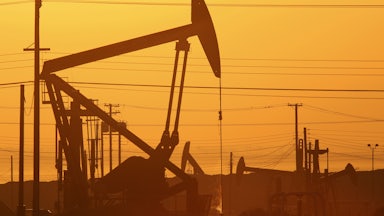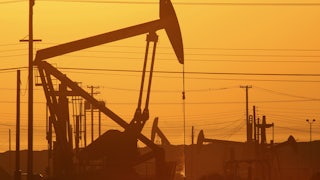Several things can be true at the same time. Vladimir Putin, for instance, can be an imperialist ghoul who started a 170,000-troop pissing contest along Russia and its allies’ borders with Ukraine. And the United States can be a declining empire that has helped inflame the situation in its quest to climb back atop the so-called rules-based international order. Similarly, German Chancellor Olaf Scholz moving to at least temporarily halt the Nord Stream 2 pipeline can be good news for the planet but also good news for the companies destroying the planet.
Chancellor Scholz announced Tuesday, shortly after news broke of Putin ordering troops to separatist regions in Ukraine, that he was hitting “pause” on the certification process for Nord Stream 2. And on Wednesday, President Biden said he would be adding sanctions on the company behind the pipeline project.
The completed but not yet operational pipeline would deliver 55 billion cubic tons of gas per year to Europe under the Baltic Sea, bypassing Ukraine to land in northern Germany. But it wasn’t delivering anything yet, and stopping it now doesn’t have much immediate bearing on Europe’s energy troubles. Climate campaigners have long objected to the pipeline based on its environmental impact and projected emissions footprint, arguing that it’s out of step with Europe’s emissions-reductions goals and the Paris Agreement. The project had attracted a very different kind of bipartisan opposition in the U.S. for fear it would bring Europe—and Germany, especially—closer to Russia. People like Texas Senator Ted Cruz aren’t fiercely opposed to Nord Stream 2 because it would lock in carbon and methane emissions but because his American fossil fuel donors stand to benefit from flooding Europe with their own gas instead. Promoting U.S.-sourced liquid natural gas, or LNG, as a viable alternative to Russian gas in Europe has been a long-standing fixture of U.S. foreign policy, drawing support from both parties.
Now LNG champions have the perfect excuse to double down. A flotilla of tankers that headed toward Europe in January has been hailed as a kind of Berlin airlift moment, helping to supplement European gas supplies in case Russia cuts off its own flows as the conflict escalates. Europe has been the top destination for U.S. LNG exports for the last three months, and ratepayers there are spending preciously for it—to be clear, this is not charity. “The extraordinary growth in U.S. oil and gas production is a geopolitical and economic asset for the U.S. that contributes to global energy security,” Daniel Yergin, venerated author of The Prize and industry booster, wrote in an op-ed for The Wall Street Journal last week. Spare capacity from shale production in the U.S. can be a lifeline to Europe—something Putin, according to Yergin, sees as a “grave threat.” America’s national security interests and its goals for energy dominance are allegedly one and the same.
The fossil fuel industry itself seems almost giddy at the prospect of further disruption; escalating tensions have already helped it fetch high prices abroad and a privileged audience with U.S. and European governments, according to recent reporting from The Wall Street Journal. In the next few months, the conflict could lead U.S. and EU authorities to greenlight long-term contracts with European buyers as well as new infrastructure at home and abroad. Several projects are already moving ahead stateside. The gas exporter Tellurian—where Amos Hochstein, the State Department’s senior adviser for energy security, worked until shortly before joining the Biden administration—seems eager to make the unusually risky move to proceed with building its Driftwood LNG terminal on the Gulf Coast without having secured all the necessary financing. The decision could signal the company’s confidence that high prices and a tight market will deliver what it needs to reach completion.
American Petroleum Institute head Mike Sommers has been making the rounds to whatever news outlets will have him, arguing that by “not asking American producers to produce more,” the U.S. is fostering “dependency on foreign regimes that do not have the best interest of America at heart,” as he told Fox Business last week. “Few things are more important than providing #energy security to our friends in #Europe,” Sommers tweeted on Tuesday. “Actions to restrict U.S. natural gas and oil production are steps in the wrong direction. Now is the time to ensure access to affordable, reliable energy for our allies and ourselves.” Presenting their wishlist for bringing down higher gas prices—expanding oil and gas leasing on public lands, loosening regulations, and rescinding Sarah Bloom Raskin’s nomination at the Federal Reserve, among other items—Western Energy Alliance President Kathleen Sgamma and Dan Natz, executive vice president for government relations and political affairs at the Independent Petroleum Association of America, chided Biden for “begging OPEC and Russia for help,” encouraging him to “pursue an energy strategy that unleashes the ingenuity of the American oil and natural gas worker.”
To summarize, the yarn being spun by the industry and the Republican politicians it bankrolls goes something like this: Domestic oil and gas producers are poised to furnish lower gas prices and energy security at home and abroad, but artificial constraints on production imposed by Democrats in the White House—whether blocking pipelines or being too stingy with oil and gas lease sales—are holding them back, leaving the U.S. and its allies perilously dependent on nefarious foreign governments.
Meanwhile, actual oil and gas producers are telling a very different story.
Before the pandemic, investors had lost patience with the bad economics of the shale boom, in which drillers burned through cash to dig up as much oil and gas as quickly as possible. By the spring of 2019, only about one in 10 North American shale producers had positive cash flow. Only sky-high oil prices and cheap debt could make these capital-intensive techniques viable. High prices, that is, are good for shale producers. And for a whole host of reasons, they don’t seem interested in producing enough to lower them. While the administration has aggressively encouraged U.S. oil and gas companies to boost production, major shale players like Pioneer Natural Resources Co., Devon Energy Corp., and Continental Resources Inc. have pledged to limit 2022 production increases to no more than 5 percent so as to rebuild trust with Wall Street. “Whether it’s $150 oil, $200 oil, or $100 oil, we’re not going to change our growth plans,” Pioneer CEO Scott Sheffield told Bloomberg. “If the president wants us to grow, I just don’t think the industry can grow anyway.” Though North American rig counts are ticking upward, they’re still lagging behind the kind of increase that would be expected given how high prices are. Larger, diversified drillers like Exxon and Chevron, meanwhile, who are planning for shale growth, are on track to deliver a record $38 billion to shareholders this year via stock buybacks.
As Bloomberg columnist Liam Denning points out, U.S. oil refiners—who buy the cheapest stuff they can process—have also been importing more fuel from Russia as a result of punishing sanctions on Venezuela. Lifting sanctions on Iran could also release an additional million barrels a day onto the world market, relieving some price pressures.
Even if it were true that patriotic U.S. producers were being held back from meeting the world’s energy needs, it’s not at all clear that they’re actually suited to be saviors. There’s additional import capacity available in Europe to “regasify” U.S. supplies as they come to European shores after being liquefied for export via tanker—through Spain, especially—but limited ability to disperse them across the continent.
With any hope, there won’t be a war or an unusually long, cold winter; Russia won’t cut off supplies to Europe; and the governments best positioned to make a rapid transition away from fossil fuels—the U.S. and EU—won’t be convinced to build a fleet of new fossil fuel infrastructure that won’t come online to solve any short-term problems but will lock in carbon and methane emissions for decades to come. Ideally, Europe will use this winter’s crisis as an opportunity to spare no expense on the kind of rapid decarbonization and energy efficiency measures that would make it genuinely energy independent. A mass buildout of electric heat pumps, for instance, could ensure Europeans can heat their homes without gas. There are some encouraging signs in that direction from a new EU strategy set to be announced March 2, to reduce fossil fuel usage by 40 percent through 2030. But there are plenty of U.S. executives eager to see Europe hooked on their fumes for years to come.










